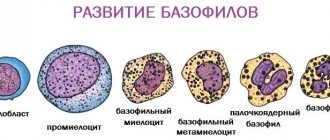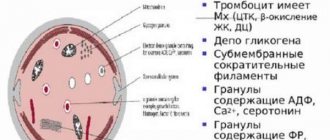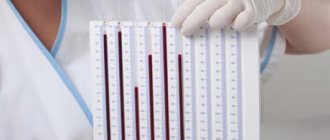What is ESR?
Erythrocyte sedimentation rate (ESR for short) is one of the main indicators that is included in a general blood test.
ESR is a nonspecific parameter because it can change under the influence of various factors, and it is not possible to determine the main reason for its change in the human body without additional research.
ESR shows at what speed red blood cells, while settling in a test tube taken for a blood test, sink to its bottom under the influence of gravity.
This process takes place the faster, the heavier and larger these particles formed during the adhesion of red blood cells. Also, the sticking of red blood cells is due to the fact that changes occur in the electrochemical composition of the blood.
The altered composition of the blood occurs due to the attachment of acute-phase protein and antibodies (immunoglobulins) to the surface of red blood cells, which enter the blood during inflammatory processes, during infection with bacteria, viruses and other harmful microorganisms.
Since the electrochemical composition of the blood can change for other reasons, in the case of a high ESR value, it is necessary to additionally conduct a biochemical analysis to determine whether an inflammatory process is currently occurring in the body or not.
How to lower the value with medication
Medicines that quickly reduce ESR levels in the blood can be hazardous to health if taken independently. Therefore, they should be prescribed by a doctor after a full examination that identifies the causes of the violations that have arisen.
Folic acid
The drug belongs to the stimulants of hematopoiesis (blood formation). Available in tablet form. Takes part in the synthesis of nucleic and amino acids, pyrimidines and other substances necessary for the normal functioning of the body.
Important information: What are leukocytes, platelets and red blood cells table (structure and functions)
Folic acid is almost completely absorbed from the digestive tract. Binds to plasma proteins. Subject to breakdown in liver tissue with the formation of tetrahydrofolic acid. It is evacuated from the body with the kidneys in the form of decay products.
With an increase in ESR caused by anemia, the initial dose of the drug is 1 mg per day. The use of large dosages of the drug is contraindicated due to the risk of developing tolerance to folic acid.
During maintenance treatment, the daily dosage changes:
- newborns - 0.1 mg;
- up to 4 years of age - 0.3 mg;
- patients over 4 years of age and adults - 0.4 mg;
- during pregnancy - from 0.1 to 0.8 mg.
The dose is increased to 5 mg per day with:
- alcoholism;
- hemolytic anemia;
- chronic infections;
- chronic stress;
- liver failure and hepatitis;
- malabsorption.
Hemodin
There are no cases of using the drug Hemodin with elevated ESR.
Totem
The drug is intended for oral administration. The main active ingredients are iron gluconate dihydrate, manganese gluconate, copper gluconate. It is a dark-colored liquid with a peculiar odor and a small amount of sediment.
Iron, which is part of the drug, is necessary for the normal process of heme synthesis, the main component of hemoglobin. Copper and manganese are microelements that are cofactors of the most important enzymes. Absorption of the drug occurs in the duodenum and occurs faster when there is a lack of iron in the body.
The medication is indicated for bleeding and increased body need for iron. It is prescribed for pathologies accompanied by an increase in ESR levels.
To correct indicators, the drug is administered orally by dissolving the required amount of the contents of the ampoules in water. Adults are prescribed 2 to 4 ampoules per day. For children, the amount of solution is determined based on the dosage of the amount of iron - from 5 to 7 mg per 1 kg of body weight.
Pyrazinamide
This is a drug used to eliminate the localization of the focus of activity of tuberculosis pathogens. With this disease, there is an increase in ESR. When treating tuberculosis with Pyrazinamide, mycobacteria acquire tolerance to the active component of the drug, so it is prescribed together with Isoniazid. The drug manifests itself as a bacteriostatic agent.
Indicated for tuberculosis, accompanied by a persistent increase in ESR in a blood test.
The drug should be taken orally after meals. The dose for adults is 1 to 2 g per day. It is divided into several doses. For older people and people suffering from dystrophy, the recommended dosage may be reduced. For children, the daily amount of the drug is determined from the ratio of 20-30 mg per 1 kg of body weight.
Important information: What do elevated white blood cells mean in a child’s blood test?
Rifampicin
This drug is used to treat tuberculosis. Taking the medication helps reduce ESR values. It is used to treat severe infectious pathologies of the lower respiratory tract, urinary system, and gall bladder. Active against staphylococci, gonococci and meningococci. These microorganisms develop resistance to this drug.
To reduce ESR, this drug is used on an empty stomach one hour before meals. The permissible dose is up to 0.6 g of Rifampicin. Intravenous administration of the drug is sometimes indicated for adults: the maximum dose is 0.6 g per day. Intravenous administration is prescribed for:
- acute progressive form of tuberculosis;
- purulent and septic processes;
- severe patient conditions.
Ethambutol
This drug belongs to anti-tuberculosis medications. Penetrating into the cell, it disrupts the synthesis processes of the bacterial cell. Active against tuberculosis bacilli and mycobacteria. A small number of microbes acquire resistance to the active component of the drug, ethambutol. The drug is excreted from the body by the kidneys.
Indicated for elevated ESR due to tuberculosis. Injected internally. The acceptable dosage of the drug is calculated based on 15 mg/1 kg of patient weight. The maximum amount is 20 mg of Ethambutol per day. The duration of treatment is at least 2 months. After this, the red blood cell sedimentation rate may decrease.
Norms
The sedimentation rate of blood cells is measured in millimeters per hour. ESR standards depend on gender, age and some other factors.
So the norm is:
- newborn – should not exceed 2 mm per hour;
- child up to 6 months – 12-17 mm per hour;
- in men – 1-10 mm per hour;
- in women – 2-15 mm per hour;
- pregnant women – up to 25 mm per hour;
- women during menstruation - up to 40 mm per hour;
- elderly people (over 60 years old) – 15-20 mm per hour.
Causes of elevated ESR
In order to understand how to lower ESR, you first need to find out the possible reasons for the increase in this indicator. ESR may increase due to pathological and physiological factors.
When the erythrocyte sedimentation rate has increased due to reasons other than disease, it may be due to the following factors:
In pregnant women, ESR is almost always elevated, and the indicator returns back to normal only after the birth of the child, somewhere in the second week after birth.
With regular monthly menstruation, elevated levels are not a reason for excessive concern and urgent examination.
If the level of hemoglobin in the blood is low, a change in the shape of red blood cells may be an important factor. Also, with an increase in cholesterol, the composition of the blood plasma can change, which, in turn, leads to accelerated sedimentation of blood cells.
There are other reasons as a result of which the ESR indicator may deviate from the norm:
- increased number of blood cells (polycythemia);
- increased blood acidity;
- taking nonsteroidal analgesics;
- in case of chronic heart failure;
- a modified form of blood red cells, inherited.
To determine the specific cause of changes in ESR, of course, you need to conduct a full medical examination.
The variety of possible causes of an increased erythrocyte sedimentation rate suggests that when the next problem appears, you should definitely entrust the situation to an experienced specialist.
An increased rate of erythrocyte sedimentation in the blood of a child in most cases is caused by inflammatory processes in the body.
In addition, other factors can be identified that lead to an increase in ESR in children:
- impaired metabolism;
- injury received;
- acute poisoning;
- stressful state;
- autoimmune diseases;
- allergic reaction;
- the presence of sluggish infectious diseases or common helminths.
In children, an increased erythrocyte sedimentation rate can occur due to an unbalanced diet, a deficiency of essential vitamins, and also in the case of teething.
If a child complains of general malaise, you should definitely contact a specialist and conduct a comprehensive examination of the body.
After receiving the results, the doctor can identify the main cause of the increased ESR, and after that the necessary treatment will be prescribed.
Elevated ESR requires examination
The main factor accelerating ESR is rightfully considered to be a change in the physicochemical properties and composition of the blood: a shift in the protein A/G (albumin-globulin) coefficient towards a decrease, an increase in the pH value, active saturation of red blood cells (erythrocytes) with hemoglobin. Plasma proteins that carry out the process of erythrocyte sedimentation are called agglomerins
.
An increase in the level of the globulin fraction, fibrinogen, cholesterol, and an increase in the aggregation abilities of red blood cells occurs in many pathological conditions, which are considered the causes of high ESR in a general blood test:
- Acute and chronic inflammatory processes of infectious origin (pneumonia, rheumatism, syphilis, tuberculosis, sepsis). Using this laboratory test, one can judge the stage of the disease, the subsidence of the process, and the effectiveness of therapy. The synthesis of “acute phase” proteins in the acute period and the enhanced production of immunoglobulins at the height of “military operations” significantly increase the aggregation abilities of erythrocytes and the formation of coin columns by them. It should be noted that bacterial infections give higher numbers compared to viral lesions.
- Collagenosis (rheumatoid polyarthritis).
- Heart damage (myocardial infarction - damage to the heart muscle, inflammation, synthesis of “acute phase” proteins, including fibrinogen, increased aggregation of red blood cells, formation of coin columns - increased ESR).
- Diseases of the liver (hepatitis), pancreas (destructive pancreatitis), intestines (Crohn's disease, ulcerative colitis), kidneys (nephrotic syndrome).
- Endocrine pathology (diabetes mellitus, thyrotoxicosis).
- Hematological diseases (anemia, lymphogranulomatosis, myeloma).
- Injury to organs and tissues (surgeries, wounds and bone fractures) - any damage increases the ability of red blood cells to aggregate.
- Lead or arsenic poisoning.
- Conditions accompanied by severe intoxication.
- Malignant neoplasms. Of course, it is unlikely that the test can claim to be the main diagnostic sign for oncology, but its increase will one way or another create many questions that will have to be answered.
- Monoclonal gammopathies (Waldenström's macroglobulinemia, immunoproliferative processes).
- High cholesterol levels (hypercholesterolemia).
- Exposure to certain medications (morphine, dextran, vitamin D, methyldopa).
However, at different periods of the same process or under different pathological conditions, ESR does not change the same:
- A very sharp increase in ESR to 60-80 mm/hour is typical for myeloma, lymphosarcoma and other tumors.
- Tuberculosis in the initial stages does not change the erythrocyte sedimentation rate, but if it is not stopped or a complication occurs, the rate will quickly creep up.
- In the acute period of infection, the ESR will begin to increase only from 2-3 days, but may not decrease for quite a long time, for example, with lobar pneumonia - the crisis has passed, the disease recedes, but the ESR persists.
- It is unlikely that this laboratory test will be able to help on the first day of acute appendicitis, since it will be within normal limits.
- Active rheumatism can last for a long time with an increase in ESR, but without frightening numbers, but its decrease should alert you to the development of heart failure (blood thickening, acidosis).
- Usually, when the infectious process subsides, the total number of leukocytes returns to normal first (eosinophils and lymphocytes remain to complete the reaction), ESR is somewhat delayed and decreases later.
Meanwhile, long-term persistence of high ESR values (20-40, or even 75 mm/hour and above) in infectious and inflammatory diseases of any kind will most likely suggest complications, and in the absence of obvious infections, the presence of some then hidden and possibly very serious diseases. And, although not in all cancer patients the disease begins with an increase in ESR, its high level (70 mm/hour and above) in the absence of an inflammatory process most often occurs in oncology, because the tumor will sooner or later cause significant damage to the tissues, the damage of which will ultimately result. As a result, the erythrocyte sedimentation rate will begin to increase.
Methods for reducing ESR
What is needed to reduce ESR in the blood? There is only one way to reduce this indicator: to cure the disease that causes its increase.
It is not recommended to use dietary supplements, antibiotics and various anti-inflammatory drugs on your own, since an individual approach to the treatment of each disease is required. It should be remembered that only a doctor can make the only correct diagnosis.
In order to identify the true cause of the increase in ESR, a person will need to conduct a comprehensive examination of the body. After the doctor makes a diagnosis, he should explain which method is best for you to lower the ESR in the blood.
He will prescribe appropriate treatment, and a few days later he will give a referral for a secondary blood test. If this indicator begins to decrease, albeit slowly, this is a signal that the treatment prescribed to you is having a positive result.
Traditional medicine recipes
How to quickly lower ESR in the blood before taking a test?
It is necessary to understand that it is absolutely unacceptable to lower the level of erythrocyte sedimentation rate using folk remedies alone.
Of course, some plants are able to cleanse the blood, improve its performance, and relieve inflammation. With the help of medicinal plants, a weakened body will cope with the disease much faster, the composition of the blood will noticeably improve, as a result of which this indicator can be reduced.
So, how to reduce ESR in the blood at home?
To do this, it is recommended to use the following traditional medicine:
- Beet.
Let's take a closer look at the recipes.
Beet
This root vegetable has long been famous for its property of purifying the blood. If ESR is elevated, you can prepare this medicine:
- Wash two dark red medium-sized root vegetables thoroughly, peel, place in an enamel pan, cover with three liters of water and bring to a boil.
- Cook the beets until fully cooked for 2-3 hours (depending on the size of the beets).
- Cool the broth and drink half a glass in the morning on an empty stomach before breakfast.
You can also make freshly squeezed beet juice or consume pre-grated beets with a small amount of honey every day.
Honey
An excellent effect can be achieved using a medicinal mixture of garlic and lemon juice.
To do this, take 2 large garlic heads and 2-3 medium lemons. Peel and chop the garlic, and squeeze the juice from the lemons.
Combine lemon juice with the resulting garlic pulp, mix well and place the resulting medicine in the refrigerator. It should be used after meals 2 times a day
.
Many medicinal herbs known to us will also help lower the erythrocyte sedimentation rate. The most effective and popular are considered to be coltsfoot, chamomile, calendula, sea buckthorn and linden blossom:
Anyone who wants to lower ESR using folk remedies should always remember the importance of a healthy lifestyle.
Regular walks in the fresh air and simple breathing exercises help improve the functioning of the lungs, and therefore increase the amount of oxygen in them, and normalize the erythrocyte sedimentation rate.
A healthy and nutritious diet, timely preventive examinations and strict treatment of all diseases will help maintain your health and, accordingly, improve your blood counts.
According to medical statistics, those who are faced with an increased ESR:
- in 23% of cases they suffer from infectious diseases;
- Oncology is detected in 17% of those studied;
- 8% experience a state of weakness caused by anemia;
- other patients with an increased erythrocyte sedimentation rate suffer from inflammation of the pancreas, prostatitis, diabetes mellitus, and colitis.
How to lower ESR during infection
In infectious diseases, high ESR values in a blood test are explained by the active production of antibodies to antigens of viruses, bacteria, and fungi. In the blood in response to infection:
- the concentration of immunoglobulins (Ig) increases;
- the concentration of leukocytes and lymphocytes increases;
- decay products of one’s own cells and fragments of destroyed bacteria, viruses, and fungi appear;
- toxic waste products of pathogenic microorganisms accumulate.
All these changes affect the physical and chemical characteristics of the blood, which leads to an increase in ESR. Thus, in case of an infectious disease, a sharp increase in ESR already 1-2 days after the onset of clinical symptoms is an indicator of the activity of the immune system and does not require any special lowering measures.
After recovery and disappearance of the pathogens, the concentration of Ig and other proteins involved in inflammation will decrease, and ESR levels will normalize. On average, it takes 2-3 weeks to restore ESR after an infection, but sometimes this process can last 1 month or more.
The period of decrease in ESR after illness depends on the type of infection and the severity of the disease.
Thus, after tuberculosis, ROE can return to normal within 2 months after recovery. With mycoplasmosis, ESR can rise to 60 mm per hour, and with parainfluenza it rises slightly and quickly returns to normal.
In infectious diseases, the erythrocyte sedimentation rate naturally decreases after recovery. To help antibiotics, anti-inflammatory drugs, antimycotics, and antiviral drugs that treat infections, medicinal plants with anti-inflammatory properties are additionally used.
Plants such as:
- raspberries - leaves, green branches, fruits, flowers;
- yellow clover;
- marsh cinquefoil;
- chamomile;
- linden - flowers;
- calendula - flowers;
- coltsfoot.
What medications can be used to reduce ESR?
In order to bring the blood ESR back to normal, it is necessary to establish the disease that led to poor health. Each ailment requires an individual treatment regimen. It is also important to identify concomitant chronic diseases that may require adjustment of the therapeutic course. This is within the competence of only an experienced doctor with many years of practice.
If ESR deviations from the norm are detected, the patient is given a second referral for blood donation. It is better to send the biomaterial for research to another laboratory. If the results are confirmed, treatment for elevated erythrocyte sedimentation rate may be as follows:
- In case of anemia, it is important to normalize hemoglobin. This can be done by taking Hematogen. Also review your daily diet. This should include chicken liver, meat products devoid of fat and skin, buckwheat porridge, flavored with fish baked in foil. For dessert you can eat pomegranate, it copes well with anemia. Add folic acid. Choose a vitamin complex with a large amount of vitamin B12. Load up on green vegetables, salad, grains, rabbit, veal, shellfish, legumes, nuts, black currants, rose hips, beets, prunes and raisins.
- If the patient is worried about rheumatism, anti-inflammatory and antihistamines and corticosteroids are used to lower the ESR to normal values. It is difficult to cure rheumatism or at least achieve long-term remission; prepare yourself for a long recovery course. Stick to a healthy diet and dress warmly.
- If the kidneys and pancreas leave much to be desired, inflammation of the gallbladder and organs of the respiratory system is detected, antibiotics that destroy bacteria and infections will help. It is better to choose a broad-spectrum antibiotic from the latest generation of drugs. They have fewer side effects and contraindications. If possible, get tested for bacterial flora. This study identifies pathogenic flora and infections, determines sensitivity to individual active substances.
- Today, tuberculosis is detected even in healthy patients who lead a healthy lifestyle. One has only to be near a person suffering from an open form of tuberculosis, as the immune system weakens and the ESR rises sharply. Tuberculosis is treated from six months to 2 years. The inflammatory process can be so strong that even after apparent recovery, red blood cells continue to settle at a high rate for several more weeks. This encourages you to strengthen your defenses, exercise, take vitamins, and maintain proper and nutritious nutrition.
- An ESR reading of 75 mm/h should be of great concern to the attending physician. Most likely we are talking about a malignant tumor. Therefore, it is urgent to undergo additional examination to detect oncology. In this condition of the body, the spread of metastases to neighboring organs and tissues is diagnosed. Maintenance therapy is recommended.
Every person who monitors their health is recommended to undergo examination and take a blood test at least once a year, and not only in case of deterioration of their condition or ailments, but simply for themselves for preventive purposes. Based on the results of a blood test, various abnormalities can be detected and certain diseases can be diagnosed, especially when any component measured is much lower or higher than normal.
One of these indicators is the level of ESR in the blood, or in medical language the erythrocyte sedimentation rate (red cells). An increase in ESR is not stated as a separate disease, but nevertheless may indicate the influence of some factor on the body or the presence of an infectious disease. To understand how to lower the erythrocyte sedimentation rate in the blood, you need to understand and deal with the reason for its increase.
Significance of ESR
To date, scientists have identified several types of cancer. These include cancer, sarcoma, leukemia and lymphoma. But the reasons why they develop have not been established.
Experts have identified a number of factors that significantly increase the likelihood of developing cancer, for example, regular alcohol consumption, hormonal imbalances, smoking, unfavorable environmental conditions, and exposure to toxic substances.
Oncological diseases may not appear for several years. It is often possible to determine the presence of cancer through laboratory tests. The reasons for visiting a doctor are lack of appetite, chronic fatigue, and lumps on the skin.
To establish the disease, a general blood test is prescribed. ESR in oncology is the main indicator, but to accurately establish the disease, a set of diagnostic measures is used.
Ultrasound, MRI, CT and other examinations are prescribed to confirm the diagnosis. A decreased or increased level of ESR in the blood indicates various pathological changes in the body.
Does red cell sedimentation rate increase with cancer? This question is asked by many patients who experience a sharp change in ESR levels.
Most often, an increase in erythrocyte sedimentation rate is observed in oncology. Based on the results of a general blood test, the doctor makes a preliminary diagnosis
. That is why, when identifying and treating cancer tumors, one of the important indicators is ESR.
What is the norm and common causes of high ESR
Each person has their own, it depends on gender, age, and health status. But there are conditional normal boundaries that are used for diagnosis. The indicator is expressed in millimeters per hour (mm/h).
- In children: newborns - up to 1 mm/h; 0-6 months - 2-5 mm/h; 6-12 months -4-10 mm/h; from one to 10 years - 4-12 mm/h; in adolescents under 18 years old - 2-12 mm/h;
- In adult men - from 1 to 10 mm/h;
- In adult women - from 2 to 15 mm/h;
- For people of retirement age - from 2 to 38 mm/h (for men); from 2 to 53 (for women).
The cause of an elevated ESR may be inflammatory processes occurring in the body. However, it is impossible to determine a specific disease based on one indicator; additional examination will be required. But, the main reasons may be related to:
- viruses and infectious diseases (pneumonia, tuberculosis and other respiratory diseases);
- diseases of the liver (hepatitis, cirrhosis, etc.) and kidneys;
- organ pathologies;
- endocrine system disorders;
- destruction of connective tissues;
- the formation of malignant tumors;
- pregnancy.
Video: clinical blood test, ESR, Dr. Komarovsky
Among laboratory diagnostic methods, perhaps the most common is a blood test for ESR - erythrocyte sedimentation rate
.
It is prescribed by every doctor after the first consultation. This can be explained by the ease of implementation and insignificant financial costs.
As for the information content of ESR, the indicator only indicates the possible presence of infection and inflammation in the body
, but the reason remains unknown without further research.
However, ESR analysis is a good method of initial diagnosis
, allowing you to determine the further course of medical actions.
Thus, a deviation of this parameter from the norm, especially upward, in most cases indicates some kind of trouble in the body
, but sometimes ESR is elevated for reasons not related to disease.
That is, the disease can occur with a normal erythrocyte sedimentation rate, and a person can be completely healthy with an elevated ESR in the blood. This blood test parameter is very individual
, and its deviation from the norm to a greater extent has many reasons.
Normal values of ESR in the blood vary from person to person depending on gender, age and even individual characteristics. Yes, in men
this indicator normally ranges from 2-12 mm/h,
in women
- 3-20 mm/h.
With age, ESR tends to increase, so in older people
this figure is within the normal range at values up to 40-50 mm/h.
In children
For newborns, the norm is an ESR of 0-2 mm/h, from 2 to 12 months - 2-10 mm/h, from 1 year to 5 years - 5-11 mm/h, and in older children - 4- 12 mm/h.
Deviation from the norm is much more often observed in the direction of increase than decrease. Sometimes the analysis gives an inaccurate result, for example, if the rules for its implementation were violated (blood must be donated before breakfast in the morning), or the person ate too much the day before or, on the contrary, was fasting. In such a situation, it makes sense to retake
analysis after some time.
How to reduce ESR in the blood?
A decrease in ESR in the blood is advisable only when, based on the results of an additional examination, a disease or other factor affecting the indicator is identified. Indeed, in some cases it is not necessary to lower the ESR and it simply will not work, for example, how to lower the ESR in the blood of women in an interesting position? No way. Until a woman has a baby and some time passes after childbirth, the indicator will be overestimated. The same applies to ways to lower ESR in the blood of men; an inflated result may be due to incorrect conduct or preparation for the study, or to the presence of a disease that only a doctor can diagnose.
So, there is no specific way to reduce the ESR level; in most cases, you need to eliminate the inflammatory process and cure a certain disease. Only a doctor can decide how to reduce ESR in the blood and the need for these measures. It is contraindicated to independently start taking antibiotics, anti-inflammatory drugs, dietary supplements and other medications that supposedly will help reduce the level of your ESR. This can cause irreparable harm to your health!
Choosing methods to lower the ESR in a child’s blood is even more unwise. In young children, a slight increase in the indicator may be associated with teething, a lack of certain vitamins, poor nutrition and many other reasons. Therefore, a slight deviation from the norm is not a cause for concern.
You can lower the ESR in the blood using alternative traditional medicine and only after consulting a doctor.
How to lower ESR with drugs
Test results are affected by medications taken. Usually, before undergoing an examination, the doctor discusses with the patient the need to stop taking medications, since when they are used, the test may show a reduced ESR in the blood in men and women.
The analysis provides information about the presence of an inflammatory process in the body. It is used to monitor infectious, autoimmune, oncological diseases and complex pathological processes. In order to lower ESR, it is necessary to eliminate the cause that contributes to its increase.
In anemia, the erythrocyte sedimentation rate will decrease if hemoglobin is increased. If there are significant deviations from the norm in iron-containing protein, folic acid, Hemodin, Totema, Irovit, Maltofer are prescribed.
If tuberculosis is detected, it will not be possible to quickly lower the ESR in the blood. The disease is considered severe and has a long therapeutic course. To avoid addiction, the drugs are alternated, so the list is quite large. The most effective are Isoniazid, Pyrazinamide, Rifampicin, and Ethambutol.
If a person suffers from a chronic disease that cannot be completely cured, such as hepatitis C, it is necessary to constantly adjust the course of medications prescribed by the doctor. If you have diabetes, regularly check your glucose levels; if their levels increase, you should discuss with your doctor a possible replacement of medications that lower blood sugar.
How to reduce with folk remedies
If an increase in ESR is associated with pathological inflammatory processes, then a decrease is unlikely to occur unless treatment for the main ailment is started. But, some methods can be an excellent addition to basic drug therapy. Some tips on how to reduce ESR using folk remedies at home.
- The use of infusions and decoctions of herbs. Usually we are talking about herbs that have an anti-inflammatory effect. These include chamomile, calendula, linden, sea buckthorn, coltsfoot, lungwort, and horsetail. Brew and infuse decoctions of single-component herbs or mixtures of several. Take a large spoon several times a day. Bee honey and all types of citrus fruits: orange, lemon, grapefruit have also proven to be good antibacterial agents.
- The most popular way to lower ESR in the blood using folk remedies, as well as cleanse the blood, is to use raw beet juice. It should be taken for about 10 days, only freshly prepared, 100 g at night. In addition, you can prepare a decoction from beets. Cook the vegetable for about 3 hours along with the root over low heat, first wash the beets thoroughly. Let the broth cool and strain. Use 50 ml every morning on an empty stomach, preferably before getting out of bed.
- You can lower the ESR, both in men and women, with the help of gymnastics and recreational exercises in the fresh air. The more saturated the blood is with oxygen, the faster the indicator will return to normal.
Take care of yourself, don't get sick!
- Acceptable standards of ESR
Nowadays, medicine is constantly moving forward. Almost every day, more and more new methods of diagnosing and treating certain problems that can arise in a living organism and lead to pathology appear.
But, taking into account all the innovations, the good old ESR indicator is still popularly used for diagnostics in both adults and children. Such an analysis remains an integral examination indicator for almost any case.
The ESR indicator refers to a general blood test and can be directed from any doctor. If the indicator deviates from the norm, the cause must be established and further measures taken.
What does increased ESR in the blood mean?
ESR (you can also find the designation ROE) stands for erythrocyte sedimentation rate (red blood cells). If you look at the blood in a test tube, over time you will notice a more red and transparent exfoliation. This very time of blood separation into the upper and lower layers is affected by the erythrocyte sedimentation rate, measured in millimeters per hour.
An increased ESR in the blood can be a signal from the body about the development of a certain pathology of a different nature, by the time it begins to manifest itself.
The erythrocyte sedimentation rate makes it possible to:
How to reduce ESR in the blood using folk remedies at home?
Analysis of the ESR indicator is part of a general clinical blood test aimed at identifying pathological conditions of various organ systems.
The erythrocyte sedimentation rate may increase due to inflammatory, infectious or idiopathic diseases.
Attention! A high ESR is not an independent disorder, but a sign indicating the presence of pathology.
To find out the exact reason that caused the increase in this indicator, additional examinations are required.
What is ESR?
The rate at which red blood cells settle in a test tube under the influence of gravity is called ESR. This abbreviation stands for “erythrocyte sedimentation rate.” The settling process of red blood cells proceeds faster if the particles stick together, forming large clots. The “clumping” of red cells occurs due to electrochemical changes in the composition of the blood.
The composition of the blood changes under the influence of peptide compounds and immunoglobulins that get there due to bacterial, viral or parasitic infections. Inflammation also plays an important role in changes in ESR levels.
Acceptable standards of ESR
The normal ESR indicator is ambiguous and depends on a number of factors: the person’s age, his gender and the general condition of the body. For men, the norm is 2-10 millimeters per hour, and for women – 3-15.
For children, these numbers depend on age:
- Newborns – 0-2 mm/hour.
- Up to 6 months – 12-17 mm/hour.
In a pregnant woman, the rate can reach up to 25 mm/h, and this will be considered normal in principle. While carrying a baby, the mother may become anemic, and therefore the blood becomes thinner.
Changes in the erythrocyte sedimentation rate can also be affected by indicators related to the general analysis formula, rarefaction or thickening of the blood, and acidification.
Reasons for increasing ESR
In order to know how to reduce ESR, you must first find out the possible reason for the increase. This indicator may increase due to physiological and pathological factors.
Possible physiological reasons for increased ESR
If the erythrocyte sedimentation rate has increased not as a result of illness, then this is possible due to the following factors:
- pregnancy, menstruation in women;
- anemia;
- hydremia (blood thinning);
- if the blood gas composition has changed;
- use of hormonal contraceptives;
- blood cholesterol levels are higher than normal;
- body weight loss;
- presence of injuries;
- the research was conducted incorrectly.
In pregnant women, ESR is almost always elevated, but returns to normal a week after the birth of the child. With monthly menstruation, an increase in the indicator is not yet a reason for examination.
When hemoglobin levels are low, an important factor is the change in the shape of blood cells. When cholesterol is elevated, the composition of the blood plasma changes, which leads to accelerated erythrocyte sedimentation.
With all the external factors from which the ESR increases, there are reasons from which the indicator may also deviate from the norm:
- increased number of blood cells (polycythemia);
- high blood acidity;
- use of non-steroidal analgesics;
- presence of chronic heart failure;
- the shape of red blood cells, inherited, has been changed.
In order to find out the specific reason for the change in ESR, of course, it is necessary to conduct a full examination.
Possible reasons for increased ESR due to pathologies
- Infection in the body
. When the ESR rate increases, the first thing that comes to mind is an infection. This includes various microbes, viruses, bacteria, fungi, etc. Most often, in this way they learn about the possible presence of specific diseases (for example, tuberculosis). - Inflammatory process
. If there is inflammation in the body, the test result will definitely show it. Moreover, the higher the ESR, the stronger the inflammation. It is impossible to determine its location, but external signs and propensities for a particular disease of the patient himself will help with this. - Suppuration
. In this case, not only the analysis, but also the external manifestation of tissue decay can become a symptom. ESR here acts as an auxiliary indicator. - Rheumatological diseases
. With these, the immune system is activated, the amount of antibodies in the blood increases, which can cause an increase in ESR. - Oncological pathologies
. Any malignant neoplasm can affect blood sedimentation. If other pathologies are excluded, then if a person’s erythrocyte sedimentation rate increases, it is worthwhile to be examined for signs of cancer. - Kidney diseases
. Kidney pathologies, congenital or inherited, affect the excretory system, which can affect blood sedimentation.
The many possible reasons for the acceleration of blood sedimentation indicate that when the next problem arises, it is necessary to entrust the situation only to an experienced specialist.
How to reduce ESR in the blood with medications?
It is necessary to begin treatment only after a complete examination and identification of the cause of the disease. Therefore, the answer to the question of how to reduce ESR in the blood depends on all the factors that increase its increase.
Treatment can have several directions (medication, folk remedies), which also depend on the cause. That is, in order to reduce the rate, you need to recover.
Ways to reduce ESR in the blood:
- If the indicator is associated with the progression of infection or inflammation, then it will be possible to reduce the ESR by curing the disease itself, for example, with antibiotics (Penicillin, Tetracycline, Erythromycin, Metronidazole, Vancomycin, Aminoglycoside, Levomycetin and others)
- In some physiological conditions (pregnancy, poisoning of the body, injury), the ESR itself will return to normal after the disappearance of the physical cause.
- Some doctors may recommend Aspirin. But at the same time, you need to remember and take into account that it suppresses the synthesis of substances, and therefore can only be recommended in certain cases.
- Folk recipes for various decoctions that reduce blood sedimentation rates remain very effective, but only after the recommendation of a doctor until a certain case.
How to reduce ESR in the blood using folk remedies?
Methods of how to reduce ESR in the blood using folk remedies are mainly aimed at restoring immunity and cleansing the blood after the patient has recovered.
Various decoctions of medicinal herbs, for example, chamomile, linden, tea with raspberries, honey and lemon, are very useful for normalizing blood sedimentation.
In addition, the menu needs to be rich in fiber and natural proteins. Red beets are especially useful. You need to prepare it like this:
The serving per dose is 50 g. The course of treatment is a week.
Beetroot juice (or just grated beets without additives) is also taken to cleanse the blood. You need to drink at least 50 g of juice. There are no restrictions on intake, but you still need to know when to stop.
Citrus juices with honey also have a very beneficial effect in this situation. Vitamin complexes (on the recommendation of a doctor) will also help.
An elevated ESR can be harmless or pathological. This indicator signals a possible disease in the body or is caused by the physiological state of a person. For a specific case, there is a solution to how to reduce ESR in the blood, which is selected individually by the doctor.
High erythrocyte sedimentation rate is not considered a disease, so there is no specific cure for it in medical practice. To eliminate this problem, it is very important to determine the cause of the increase in the indicator and eliminate it.
It must be borne in mind that before reducing ESR in women, it is necessary to determine whether the indicator is abnormal, and there are good reasons for this. Since an increase may simply signal the occurrence of a natural process characteristic of ladies.
Have you encountered the problem of low ESR? What methods and medications did you use to combat this? Tell us about it in the comments.
Many people wonder how to lower ESR in the blood of women. To answer correctly, you need to understand the meaning of ESR in the body. Further it will become clear that there is no specific way to reduce its level, but the cause can be dealt with. The main thing is to understand the reason that caused this condition.
In order to notice pathology in time, you need to attend scheduled examinations and donate blood for analysis. It is worth going to the doctor not only in case of serious reasons. It is recommended to donate blood at least once a year. In case of deviations, the doctor will select conservative treatment.
What could a decrease in ESR mean?
The reader will probably agree that we attach little importance to ESR if the numbers are within the normal range, but reducing the indicator, taking into account age and gender, to 1-2 mm/hour will still raise a number of questions for particularly curious patients. For example, a general blood test of a woman of reproductive age, when examined repeatedly, “spoils” the level of erythrocyte sedimentation rate, which does not fit into the physiological parameters. Why is this happening? As in the case of an increase, a decrease in ESR also has its own reasons, due to a decrease or lack of the ability of red blood cells to aggregate and form coin columns.
when ESR decreases, one (or more) components of correct erythrocyte sedimentation are not in order
Factors leading to such deviations include:
- Increased blood viscosity, which, with an increase in the number of red blood cells (erythremia), can generally stop the sedimentation process;
- Changes in the shape of red blood cells, which, in principle, due to their irregular shape, cannot fit into coin columns (sickling, spherocytosis, etc.);
- Changes in physical and chemical blood parameters with a shift in pH downward.
Such changes in the blood are characteristic of the following conditions of the body:
- High levels of bilirubin (hyperbilirubinemia);
- Obstructive jaundice and, as a consequence, the release of large amounts of bile acids;
- Erythremia and reactive erythrocytosis;
- Sickle cell anemia;
- Chronic circulatory failure;
- Decreased fibrinogen levels (hypofibrinogenemia).
However, clinicians do not consider a decrease in erythrocyte sedimentation rate to be an important diagnostic indicator, so the data is presented specifically for particularly inquisitive people. It is clear that in men this decrease is not noticeable at all.
It is definitely not possible to determine whether your ESR has increased without a finger prick, but it is quite possible to assume an accelerated result. Increased heart rate (tachycardia), increased body temperature (fever), and other symptoms indicating the approach of an infectious-inflammatory disease can be indirect signs of changes in many hematological parameters, including the erythrocyte sedimentation rate.
Concept of erythrocyte sedimentation rate
An erythrocyte is one of the many elements of blood. The erroneous opinion of many is that the main value in analyzes is the concentration of red blood cells. Pay attention to the rate of their settling. A normal ESR in a general analysis indicates the patient’s health. When the level of ESR in the blood is too high, one can judge the presence of some pathology.
The patient's blood is drawn early in the morning on an empty stomach. It is left in the test tube for an hour. To prevent clotting, a special serum is added. After which you can see a clear line. From this moment this indicator is determined. A decrease or increase indicates the presence of a particular disease.
Throughout life, various changes occur in the body. When viruses or infections occur, the number of different blood cells changes. Research can reveal even this. For the female body, the norm for ESR is considered to be from 3 to 15 mm/h.
For comparison, you can present other figures:
- For men, the norm is considered to be from 1 to 10 units.
- For children, the norm is considered to be from 0 to 2 units.
- For infants, the norm is considered to be from 12 to 17 units.
Absolutely any violations committed during blood sampling can affect further results. These include errors in the research technique or lack of proper experience of the laboratory assistant.
Causes of high ESR levels in the blood of women
A decrease or increase in ESR levels should be treated in several stages. Often there are no symptoms. If you take different ages of women, then the indicators will be different. For younger people, the typical indicator is 3 units, and for older people it can increase to 53 units. And that's okay. Proteins contained in blood plasma also affect ESR.
The following diseases lead to an increase in ESR:
- inflammation of various organs;
- infectious diseases;
- autoimmune disorders;
- heart diseases;
- intoxication of the body;
- severe injuries.
In the presence of cancerous tumors, the ESR level reaches significant levels, in some cases very high values were recorded.
The ESR indicator in the general analysis may be increased due to anemia, obesity, renal failure, or when taking certain medications.
This coefficient is also influenced by other reasons, which include:
- age-related changes;
- menstruation;
- pregnancy.
In pregnant women, the erythrocyte sedimentation rate is almost twice as high, because during this period there is a change in the protein composition of the plasma. When the baby is born, the mother’s ESR level remains at a high level for a short period of time, but then returns to its original normal.
It is important to remember to remain calm with any results you receive. Many people immediately begin searching for self-medication. This is the wrong decision. Only a doctor can identify the disease and begin appropriate treatment.
Measures taken to reduce ESR
How to reduce ESR in the blood or how to reduce ESR? These are the most common questions asked in search engines. If everyone knew that only a doctor can give the correct answer, because no one can determine the cause of such a condition themselves. As soon as it is eliminated and eliminated, the ESR level will decrease on its own.
To eliminate the cause, a comprehensive examination of the patient is performed. After which a certain course of treatment is prescribed. Don't expect quick results - everything will come with time. The main thing is to follow the recommendations. A rapid jump from a higher to a lower reading can affect the functioning of the cardiovascular system.
The most effective are considered:
- herbal decoctions;
- honey and honeycombs;
- beet broth;
- lemon mixed with crushed garlic.
The consequences of self-medication can be very unpleasant. Many people start taking antibiotics or other anti-inflammatory drugs.
This method will not cure the underlying problem; it will most likely cause irreparable harm to the body, which can later develop into a chronic disease.











